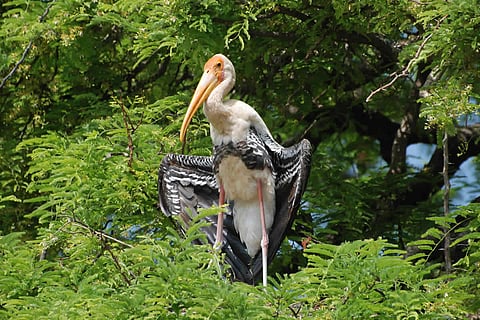

A 123-km drive from Bengaluru took us to Kaggaladu, a nondescript hamlet located in Sira, a historically significant town in Karnataka’s Tumkur district. Carpets of yellow-green paddy fields and rust-brown mature ragi heralded a warm welcome to the legendary village of the winged visitors. A sprinkling of tiny hamlets and green shrub forests added to the rural landscape.
We savoured a slice of the pastoral charm as we zipped along a winding road across the Kollambella wetland, an apparent attraction for waterfowl. Accompanied by a group of photo enthusiasts and avid birdwatchers from Bengaluru, I was on a photographic jaunt to click pictures of the annual congregation of the avian wonders.
As I roamed around Kaggaladu at a leisurely pace, I saw some of the village residents relaxing in their houses built in the traditional style with raised platforms, carved wooden pillars and red-tiled sloping roofs. The residents’ fondness for bright colours is discernible in the temple, houses and even their bullock carts. The inhabitants of the village typically follow the ancient rhythms of the agricultural calendar.
The residents have been living in harmony with the bird colony breeding in their village for several years. Kaggaladu would have remained in obscurity if Wildlife Adventure Nature Club (WANS) had not discovered it in 1999. This Tumkur-based NGO not only adopted it but also monitored and tracked the nesting colony of these winged visitors and the neighbouring wetland of Kollambella. Interestingly, Kaggaladu is said to be the second largest painted stork sanctuary in South Asia after Kokrebellur Bird Sanctuary in the state’s Mandya district.
Village temple
From December to August, Kaggaladu comes alive with shrill cries, squawks and mighty flaps of broad wings when countless painted storks and herons descend in droves, especially to build their nests and rear their young. Every tree holds many nests, and if you go in May the sight is amazing as many newborn birds learn to fly during this period, and the shrill voices of these young ones fill the environment with unusual energy. During these months, bird and man co-exist peacefully.
As we approached the heart of the village, the air resonated with the low murmuring and persistent droning of birds colonising on the large, shady tamarind and ficus trees. We were greeted by the stunning spectacle of winged visitors roosting atop trees, circling low on the ground, then swirling and soaring higher in the sky. It was fascinating to see these birds nesting in the village in very close proximity to the villagers.
It is a treat to watch the colourful painted storks glide and hover over the trees. We watched in delight a mother feeding her young ones, spreading her wings to protect her offspring from the scorching heat, and the young ones happily playing their little birdy games under the shadow of her wings.
As I strolled around, I came across some village women engaged in relaxed chatter. They informed me that the wildlife division of the Karnataka Forest department pays an annual incentive to each family to maintain the tamarind trees. “For us, these birds are simply a godsend. We have always protected them, believing that they foretell good fortune and bring rains and good crops. The fish diet of the birds provides us with abundant bird droppings rich in potassium and phosphate which are used as manure for our crops,” explained a resident.
It is strange that the birds breed only within this village. Village trees are left undisturbed for the nesting of the avian wonders. “Not a single tree in the village is touched. They are left undisturbed for the birds to nest,” said a farmer. Kaggaladu residents do not allow any outsiders to touch the trees or the birds and protect them like their own offspring. While many of the villagers are interested in protecting the birds for their visual appeal, a few believe that they are harbingers of prosperity. However, everyone likes to flaunt their long association with the birds. The residents are encouraged not to damage trees but maintain them by not pruning their branches or harvesting the ripe imli fruits as it would disturb the nests and scare the birds away.
Remains of a fort in the village
This heronry is not an officially managed one. No tickets are required to visit the sanctuary. Many environmentalists have sent proposals to the Forest department requesting an official bird sanctuary status for Kaggaladu. The department has ensured protection to the birds by deploying staff at the village during the peak season. Steps have been taken to ensure that vehicles don’t overspeed along the stretch. As the village residents lose revenue because the tamarind trees are not harvested, monetary compensation is given to them to maintain the trees. In course of time, more tamarind trees sprang up and the gram panchayat decided not to harvest them to ensure that the nests are left undisturbed.
This people-initiated conservation measure has helped curb the drastic decline in breeding numbers. The birds live in perfect harmony and mutual tolerance with the villagers and enjoy their protection – a perfect example of peaceful co-existence between man and nature. It is no wonder that Kaggaladu has earned the sobriquet of ‘People’s Bird Sanctuary’.
All pictures by Susheela Nair
Susheela Nair is an independent food, travel and lifestyle writer, and photographer based in Bangalore. She has contributed content, articles and images on food, travel, lifestyle, photography, environment and ecotourism to several reputed national publications. Her writings constitute a wide spectrum, including guide books, brochures and coffee table books.